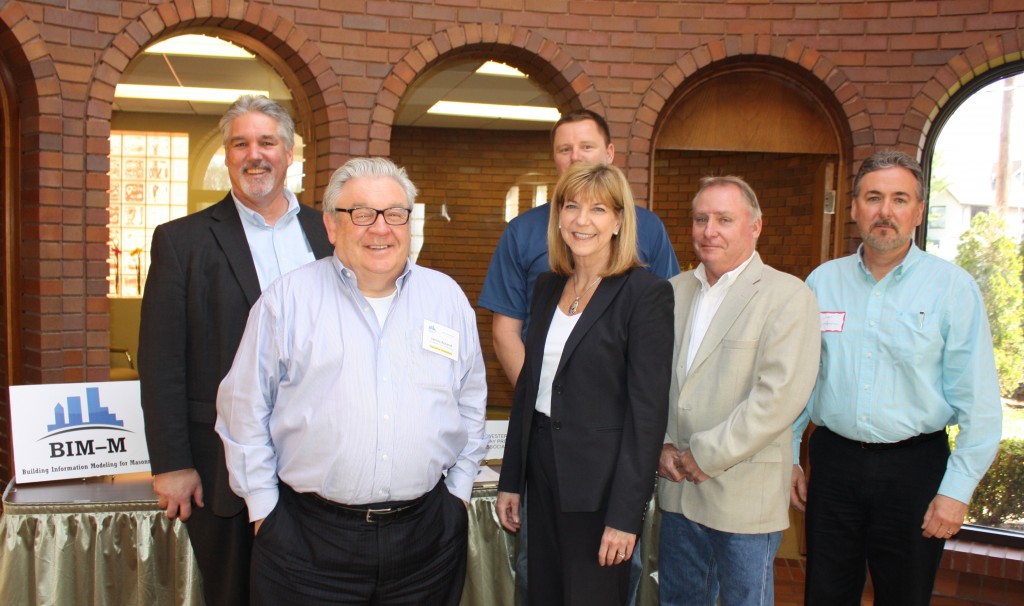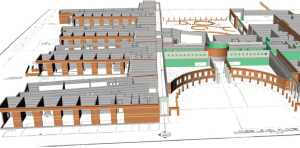
By MARY ANN HOLLEY
Correspondent
One of the world’s oldest building methods is moving into to the computer age with the use of data technology that promises higher efficiency, easier collaboration between trades and an overall smoother workflow at the jobsite.
Last month, about 100 masonry contractors, architects, software developers and officials with the International Union of Bricklayers and Allied Crafts Persons (BAC) came together for a symposium to learn more about BIM-M – Building Information Modeling for Masonry – and how masonry data models will be used by architects, mechanical engineers, construction managers, sub-contractors and fabricators.
Data not drawings is the wave of the future, said International Union President James Boland, and members of the Bricklayers’ and Allied Trades Union will be ready.
“BIM will change the dynamics and behavior of the construction supply chain, unlocking new, more efficient and collaborative ways of working. Adoption of BIM will put the masonry industry at the vanguard of a new digital construction era,” Boland said. “It is no doubt the future of masonry. It’s not a choice, but a must.”
Boland is solidly behind the initiative and said the masonry trades risk contributing to their own obsolescence if they fail to get into step with BIM.
SAVES TIME AND MONE
“BIM saves time and cost, improves estimation accuracy, reduces waste and avoids conflicts in the field,” he said. “It also provides the opportunity to showcase the benefits of designing and constructing with masonry to the owner, designer and construction manager/general contractor.”

The BIM process will show intricate 3D computerized model with construction details of walls laden with structural requirements and mechanical penetrations. Having this information will provide the mason contractor advance input and notice of the various mechanical, electrical and plumbing requirements.
Because of the information BIM provides, masonry progresses in coordination with other trades, rather than in opposition – an obvious benefit to both the BAC signatory contractor and craft workers working on the project.
The International Union of Bricklayers and Allied Craftsperson’s (BAC) and their labor management development arm, the International Masonry Institute (IMI) have, for the past three years, made a substantial financialcommitment to the BIM initiative.
INDUSTRY UNIFYING
Boland said BIM implementation will not only unify the masonry industry, it promises better collaboration between owner, architect, engineer, manufacturer, mason, contractor, construction manager and maintenance professionals.
Boland and other speakers said they don’t think the construction industry will ever totally get rid of a 2D blueprint of a wall, but that will be derived from the model.
“We will still have sections and plans derived from the 3D information so the bricklayer will still see the information how he expects,” Boland said. “The difference is there will be an iPad or tablet displaying what’s being modeled by the design team and there’ll be more data at his fingertips.”
The information will look similar, but it will be presented in a different way, available on tablets and delivered to job sites in more of a real-time way.
“We’re not expecting the guys with fingers full of mortar to try and pinch/zoom a mobile device to get to the right bit of the model and start rotating through 3D views,” Boland said. “The plans aren’t going to go away for a long time yet, they’ll just be derived from a different source.”
Bricklayers Local 1 Business Manager Don Brown says he’s very pleased that the International Union has taken on this massive task.
“BIM is the future of masonry, and if we don’t get with the program, we’re going to lose in the end,” Brown said. “Our president, Jim Boland, is progressive and intuitive, and is on target with what is best for our trades men and women. He’s doing a great job taking us into the future.”
Moving masonry forward

Building Information Modeling (BIM) is not new to the construction industry, but the masonry trades lag well behind mostothers in developing tools specifically designed to improve trade-specific planning and execution, Bricklayers International Union President James Boland said.
In the United Kingdom, BIM is already a requirement on job sites with plans to have BIM fully in place by 2016.
“If we don’t incorporate BIM technology into the masonry industry, masonry will seem difficult to work with and become uncompetitive.” says David Biggs, a program coordinator for the BIM for Masonry Initiative and a teacher of historic preservation engineering at University of Pennsylvania.
The benefits BIM provides are hard to ignore: Its 3D visualizations provide a digital representation of the building, from exterior to interior, which makes scheduling, estimating, site planning and record keeping more accurate and visual-friendly.
Also, it is capable of creating quantity takeoffs, direct fabrication, clash detection and energy analysis. Most importantly, all the building information stored in BIM can be accessed and interactively shared by designers, architects, engineers, project managers, contractors, owners and craft workers to facilitate smoother workflows and collaboration, because they can read from, and write to the same information source.
David Sovinski, national director of industry development for the IMI calls the BIM-M Initiative “the most significant cooperative masonry industry venture to be undertaken.” He says the industry has rallied together to stimulate the development of digital tools that will transform how masonry is designed and constructed.
The majority of the process-related BIM for Masonry (BIM-M) projects are focused on masonry contractors and bricklayers, because architects, engineers, materials suppliers, etc., are already using software as part of their business workflows, Sovinski said.
“This is particularly important since other competing industries are embracing the use of digital modeling, clash detection and construction coordination using BIM,” said Sovinski. “Our goal is to keep masonry competitive by leveraging our natural advantages as a quality material with a skilled labor force to combine with coming technological improvements to make sure our members are competing on a level playing field with other products and systems.”
The important thing to remember is that each of the stakeholders uses masonry models differently and need different content, Boland said.
Building Information Modelling appears to be revolutionizing every sector of architecture, engineering and construction, yet will it impact the work smaller bricklaying businesses?
“It is easy to take well-structured information and make it simple; you can always print out from a model. You can’t create a model very easily from paper,” Boland said.
As the project moves into its next phases, BAC and IMI will be working to familiarize and educate members and contractors on the use of BIM-M so that the industry will not lose any time once it is fully operational.

